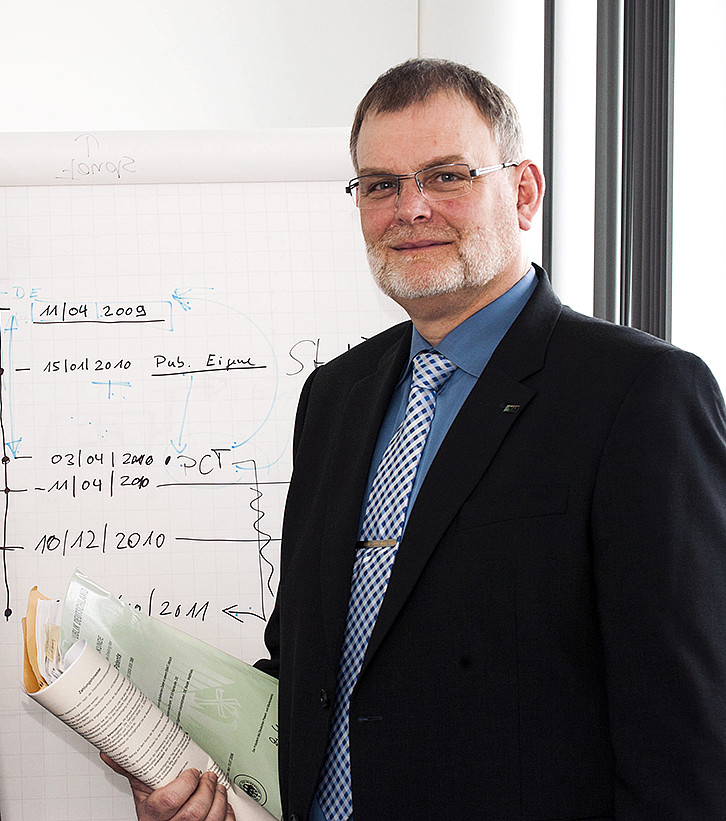Published on May 12, 2021
What does intellectual property have to do with KIT?

Spotting, protecting, and defending intellectual property rights as assets is the task of the IP Management (IPM) department in the Innovation and Relations Management (IRM) service unit at KIT. IPM is responsible for all questions of KIT employees concerning intellectual property, the application of property rights, and the negotiation of rights of use (licenses). We met Dr. Ludwig Witter, head of IPM, and asked him about the first steps in dealing with IP.
1. When should KIT scientists get in touch with IP management?
Dr. Ludwig Witter: KIT employees should contact us as early as possible if they have developed an idea for a technical solution. The corresponding contact persons can be found in the patent units on the IRM website. It is important that at this stage the characteristics of an inventive idea can already be described sufficiently scientifically and technically. We then discuss together whether an "invention" exists and, if so, how it can be protected by property rights.
The early stage also counts if an inventor or someone else is interested in acquiring rights of use of KIT intellectual property. In this case, too, the respective contact persons can be found on our website.
2. What can be protected as intellectual property?
Ludwig Witter: Intellectual property is a very broad term and is often used only as a synonym for inventions, but it encompasses much more than just this one variety of intellectual property. IPM focuses on industrial property rights, on the one hand based on technical inventions, such as the patent or utility model, and on the other hand also trademarks or designs. Copyright, which does not belong to the industrial property rights, is another field of activity for us with regard to the commercial exploitation of computer programs (software). Depending on the type and elaboration of the intellectual property, other legal protection mechanisms take effect. In addition, these can be very different in the individual nation states – despite or precisely because of globalization.
3. Are there any ways to find out if a similar IP right already exists?
Ludwig Witter: In the meantime, there are a lot of free, publicly available databases or search engines on the Internet to be able to determine with a first simple search whether something identical or similar has already been protected – for example Departis or Espacenet. For this, it is important that I can sufficiently characterize my intellectual property in terms of its features and characteristics, otherwise it will be difficult to compare. By comparing the differences, e.g. the technical specifications with which a technical problem is solved, I can further characterize and evaluate my intellectual property.
4. Who covers the costs for an application?
Ludwig Witter: For scientific employees, KIT bears the costs insofar as a fee-based application is necessary for the protection of intellectual property, e.g. in the case of an invention. Otherwise, KIT releases the rights and you can decide yourself whether you want to assume the costs as a private person.
5. In addition to intellectual property rights, IP management is also responsible for granting licenses to companies or spin-offs. When should such a license agreement be concluded?
Ludwig Witter: KIT employees should definitely contact us before they manufacture, offer, and distribute products or services that involve KIT property rights. This is particularly important in order to be able to additionally secure investments by means of a license. Also here, the earlier, the better. On the one hand, the negotiation of a license agreement requires a certain amount of time; on the other hand, there is often still the possibility to coordinate the patent strategy with the potential licensee at an early stage. This often leads to further added value in a license.
Knows the ropes: Protect IP properly
For all KIT employees who want to deal with the protection of intellectual property, the application of patents and the granting of licenses in more detail, IPM offers individual institute or work group seminars of approx. 2 hours on this subject by arrangement. Interested? Then there are two ways for you to arrange a seminar date:
- Request an appointment with Dr. Ludwig Witter via the IPM secretariat.
- Contact the patent unit responsible for your institute.
As an inventor, you can also get an overview in the FAQs on the subject of patents.
Intellectual property at KIT in figures
KIT documents the most important innovation key indicators on an annual basis. We have selected the current data from 2020 for you:
- 1,772 intellectual property rights in the total portfolio
- 65 percent of the portfolio exploited under license or R&D contracts
- 105 registered invention disclosures
- 50 patent applications filed during the year
- Approx. 150 technology offers for industry partner search
The figures for the last five years in direct comparison can be found at NEULAND.


comments about this article
No comments